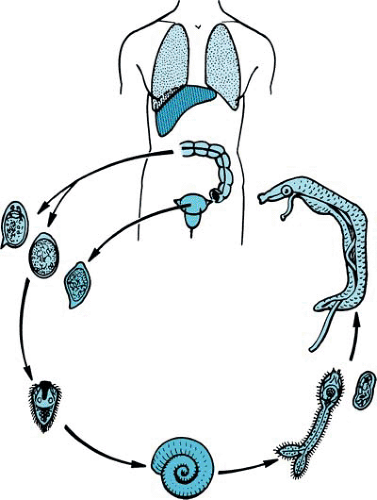Schistosomiasis
Mark W. Kline
Schistosomiasis is a disease of the circulatory system caused principally by three species of trematodes: Schistosoma mansoni, S. haematobium, and S. japonicum. Some 200 to 300 million people worldwide are infected with one of these organisms. Travel to and from endemic areas of Africa, South America, and Asia has spread the disease well beyond its historical geographic boundaries to North America and Europe. In the United States, more than 400,000 people may be infected with one of the human schistosomes. Although transmission of the infection in the United States is not possible because of the absence of snail intermediate hosts, recognition of the clinical features of the disease is key to establishing the diagnosis and providing treatment for the prevention of long-term adverse sequelae.
LIFE CYCLE
Humans are the definitive hosts for the three principal schistosome species; certain snails serve as intermediate hosts (Fig. 226.1). Deposition of eggs (oviposition) occurs in the venules of the large intestine (S. mansoni), small intestine (S. japonicum), or urinary bladder (S. haematobium) of humans. Many eggs remain in the tissues or are carried via the bloodstream to the liver or other distant body sites. A few reach the lumina of the intestine or urinary bladder and are excreted.
Free-living miracidia are released when eggs contact warm fresh water. Miracidia swim until they find an appropriate snail intermediate host; then they penetrate its tissues and begin asexual reproduction. In a few weeks, infective larvae, or cercariae, are shed from the snail and may penetrate intact human skin. After penetration occurs, the parasite develops into a worm-like schistosomulum and passes through the skin and to the lungs via lymphatics or the bloodstream. After a total period of 1 to 3 weeks, schistosomula reach the liver, where maturation and sexual reproduction occur. Adult schistosomes descend through the venous system to their preferred sites in the intestine or urinary bladder. Oviposition occurs 4 to 12 weeks after cercarial penetration of the skin has occurred.
EPIDEMIOLOGY
The geographic distribution and prevalence of schistosomiasis change continuously. The transmission of schistosomes depends absolutely on the distribution of susceptible snails. Population shifts and the introduction of irrigation have led to an increased prevalence of infection in many endemic areas. Conversely, population treatment and snail eradication programs have affected the prevalence of infection favorably in certain areas. Inhabitants of endemic areas usually encounter schistosomes during childhood and may be infected repeatedly throughout their lives. The prevalence of infection may reach adult levels during the first decade of life. The incidence of initial infections, therefore, is low in comparison with the overall prevalence and is restricted largely to children. Most infected persons have a low worm burden and pass only a few eggs in the stool or urine. Relatively small numbers of individuals are infected heavily, but they contribute disproportionately to environmental contamination and the transmission of infection. Control efforts often have been directed against these heavily infected individuals.
S. japonicum is endemic only in the Far East, with foci in China, Japan, the Philippines, Indonesia, Thailand, Laos, and Cambodia. A similar human schistosome of lesser importance, S. mekongi, first was reported from the Mekong River delta and probably is endemic throughout Southeast Asia.
S. haematobium is endemic throughout Africa and in parts of Southwest Asia and the Middle East. S. mansoni is widespread in Africa and is the only human schistosome present in the Western Hemisphere, with endemic foci in Brazil, Suriname, Venezuela, and the Caribbean. Schistosomiasis in the United States occurs mainly among immigrants from endemic areas.
S. haematobium is endemic throughout Africa and in parts of Southwest Asia and the Middle East. S. mansoni is widespread in Africa and is the only human schistosome present in the Western Hemisphere, with endemic foci in Brazil, Suriname, Venezuela, and the Caribbean. Schistosomiasis in the United States occurs mainly among immigrants from endemic areas.
 FIGURE 226.1. The life cycle of schistosomes (counterclockwise): parasite eggs passed into freshwater in human excreta hatch into miracidia that infect the intermediate host, an aquatic snail. Several weeks later, the snail releases free-swimming cercarial forms that seek and penetrate human skin, transforming into immature male or female larvae. Six to 8 weeks later, mature worms complete the cycle by mating in portal or urinary tract veins and releasing eggs into nearby viscera. (Reprinted from King CH, Mahmoud AAF. Schistosoma and other trematodes. In: Gorbach SL, Bartlett JG, Blacklow NR, eds. Infectious diseases, 3rd ed. Philadelphia: Lippincott Williams & Wilkins, 2004:2379.)
Stay updated, free articles. Join our Telegram channel
Full access? Get Clinical Tree
 Get Clinical Tree app for offline access
Get Clinical Tree app for offline access

|





